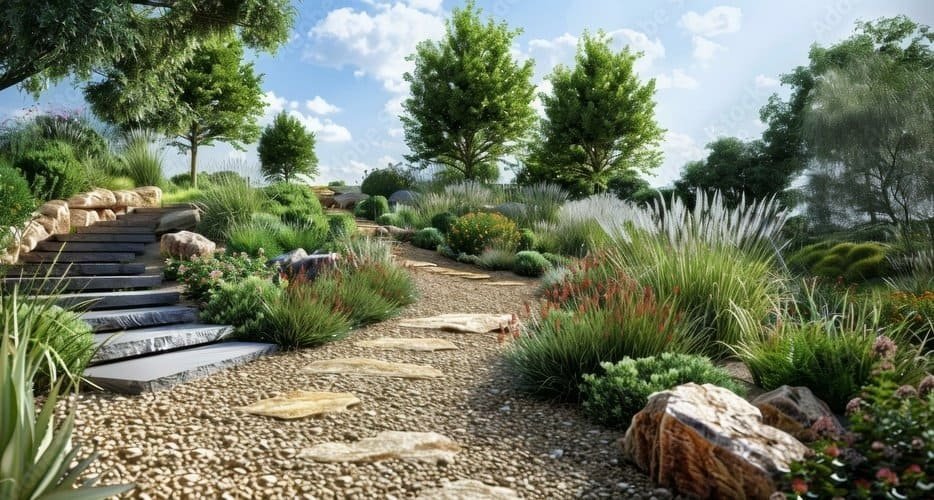Introduction
Creating a beautiful garden that requires minimal upkeep is a dream for many. By incorporating native plants into your garden design, you can achieve a stunning, low-maintenance landscape that benefits both you and the environment. At Soil Matters, we are dedicated to promoting sustainable gardening practices, and in this blog post, we’ll guide you through the steps to design a low-maintenance garden using native plants.
Why Choose Native Plants?
Native plants are species that naturally occur in a specific region and have adapted to the local climate, soil, and ecosystem. Using native plants in your garden offers numerous benefits:
- Low Maintenance: Native plants are well-suited to local conditions, requiring less water, fertilizer, and pesticides.
- Biodiversity: They support local wildlife, including pollinators like bees, butterflies, and birds.
- Environmental Benefits: Native plants help preserve the natural heritage of the area and contribute to ecosystem stability.
Steps to Design a Low-Maintenance Garden with Native Plants
1. Assess Your Garden Space
Before selecting plants, evaluate your garden’s conditions:
- Soil Type: Determine whether your soil is sandy, loamy, or clayey.
- Sunlight: Note the areas that receive full sun, partial shade, or full shade.
- Moisture: Identify areas that are dry, well-drained, or tend to be moist.
Understanding these factors will help you choose native plants that thrive in your specific garden conditions.
2. Research Native Plants
Identify native plants suitable for your region and garden conditions. Resources such as local extension services, native plant societies, and botanical gardens can provide valuable information. Consider the following types of plants:
- Perennials: Long-lasting plants that return year after year.
- Grasses: Ornamental grasses that add texture and movement.
- Shrubs: Woody plants that provide structure and year-round interest.
- Wildflowers: Colorful blooms that attract pollinators.
3. Plan Your Garden Layout
Design your garden with a mix of plant heights, colors, and textures to create visual interest and biodiversity. Group plants with similar water and sunlight needs together to make maintenance easier. Consider the following tips:
- Layering: Place taller plants at the back or center and shorter plants at the front or edges.
- Repetition: Use repeated patterns of plants to create a cohesive look.
- Pathways: Include pathways to access different areas of the garden easily.
4. Prepare the Soil
Healthy soil is crucial for a thriving garden. Amend your soil with organic matter, such as compost, to improve its structure and fertility. This step is especially important if your soil is poor or heavily compacted.
5. Plant Selection and Placement
Choose plants that suit your garden’s conditions and design. Space them according to their mature size to reduce the need for future pruning and overcrowding. Follow planting guidelines for each species, considering factors such as planting depth and spacing.

6. Mulch and Watering
Apply a layer of mulch around your plants to retain moisture, suppress weeds, and improve soil health. Use organic mulch, such as bark chips or straw, for best results. Water your plants deeply but infrequently to encourage deep root growth and drought tolerance.
7. Minimal Maintenance Practices
Once established, native plants require minimal care. Implement these low-maintenance practices:
- Pruning: Prune selectively to maintain plant health and shape, usually once a year.
- Weeding: Mulch and ground cover plants can significantly reduce the need for weeding.
- Watering: Native plants typically require less water once established, relying mainly on natural rainfall.
- Pest Management: Native plants are more resistant to local pests and diseases, reducing the need for chemical interventions.
Conclusion
Designing a low-maintenance garden with native plants is a rewarding way to create a beautiful, sustainable landscape. By choosing plants that are adapted to your local environment, you can enjoy a vibrant garden with less effort and resources. At Soil Matters, we believe in the power of native plants to transform gardens into eco-friendly sanctuaries.
For more tips on sustainable gardening and native plants, visit Soil Matters and discover how you can create a low-maintenance, environmentally friendly garden.


